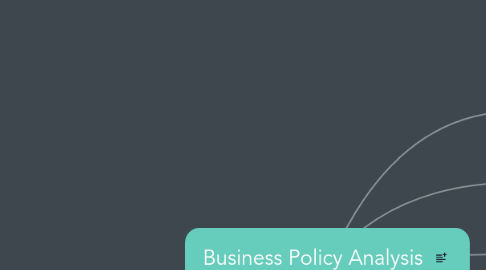
1. How does SM achieve coherence?
1.1. Company vision
1.1.1. Massively inspiring
1.1.2. Overarching
1.1.3. Long-term
1.1.4. Driven by and evokes passion
1.1.5. Fundamental statement of the organization’s
1.1.5.1. Values
1.1.5.2. Aspiration
1.1.5.3. Goals
1.2. Mission statements
1.2.1. Purpose of the company
1.2.2. Basis of competition and competitive advantages
1.2.3. More specific than vision
1.2.4. Focused on the means by which the firm will compete
1.3. Strategic objectives
1.3.1. Operationalize the mission statement
1.3.2. Guide how to fulfill “higher goals”
1.3.2.1. More specific
1.3.2.2. Cover a more well-defined time frame
1.3.2.3. Challenging
1.3.2.4. Resolve conflicts that arise
1.3.2.5. Yardstick for rewards and incentives
1.3.3. S.M.A.R.T.
1.3.3.1. Specific
1.3.3.2. Measurable
1.3.3.3. Appropriate
1.3.3.4. Realistic
1.3.3.5. Timely
2. How does SM empower?
2.1. Strategic Management Perspective
2.1.1. Integrative view of the organization
2.1.2. Assess how functional areas and activities “fit together” to achieve goals and objectives
2.1.3. All managers and employees must take and integrative, strategic perspective of issues facing the organization
2.2. Enhancing Employee Involvement
2.2.1. Local Line Leaders
2.2.1.1. Have significant profit and loss responsibility
2.2.2. Executive Leaders
2.2.2.1. Champion and guide ideas
2.2.2.2. Create a learning infrastructure
2.2.2.3. Establish a domain for taking action
2.2.3. Internal Networkers
2.2.3.1. Have little positional power and formal authority
2.2.3.2. Generate their power through the conviction and clarity of their ideas
3. What is SM?
3.1. Definition
3.1.1. How to compete in order to create competitive advantages in the marketplace
3.1.2. How to create competitive advantages in the market place
3.1.2.1. Unique and valuable
3.1.2.2. Difficult for competitors to copy or substitute
3.2. Attributes
3.2.1. Organizational direction
3.2.2. Participative decision-making
3.2.3. Inclusive perspectives
3.2.4. Balance of efficiency and effectiveness
4. What are the SM roles and relations?
4.1. Corporate governance
4.1.1. Shareholders
4.1.1.1. Two views of stakeholder management
4.1.1.1.1. Zero sum
4.1.1.1.2. Symbiosis
4.1.2. Management (led by the CEO)
4.1.3. Board of Directors
4.1.3.1. Elected representatives of the owners
4.1.3.2. Ensure interests and motives of management are aligned with those of the owners
4.1.3.2.1. Effective and engaged Board of Directors
4.1.3.2.2. Shareholder activism
4.1.3.2.3. Proper managerial rewards and incentives
4.1.3.3. Corporate scandals redefined the role and rules for board of directors with fewer areas of focus:
4.1.3.3.1. Numbers Knowledge
4.1.3.3.2. Strategy Focus
4.1.3.3.3. Time & Understanding
4.1.3.3.4. Watchdog
4.2. Social responsibility
4.2.1. Managers must take active steps to make society better
4.2.2. Socially responsible behavior changes over time
4.2.3. Triple bottom line
4.2.4. Starbucks Coffee Company
4.2.4.1. Corporate social responsibility is embedded throughout the organization.
4.2.4.2. Commitments of S.C.C. to be socially responsible:
4.2.4.2.1. Commitment to origins
4.2.4.2.2. Helping protect the environment
4.2.4.2.3. Starbucks in your community
4.2.4.2.4. Commitment to partners
5. What does SM do?
5.1. Processes
5.1.1. Strategic Analysis
5.1.1.1. Starting point of SM
5.1.1.2. Clear goals and objectives permit effective allocation of resources
5.1.1.3. Hierarchy of goals
5.1.1.3.1. Vision
5.1.1.3.2. Mission
5.1.1.3.3. Strategic objectives
5.1.1.4. Analyzing external environments
5.1.1.4.1. General environment
5.1.1.4.2. Industry environment
5.1.1.5. Frameworks for analyzing a firm’s internal environment
5.1.1.5.1. Strengths
5.1.1.5.2. Weaknesses
5.1.1.6. Intellectual assets are drivers of
5.1.1.6.1. Competitive advantage
5.1.1.6.2. Wealth creation
5.1.1.7. Networks and relationships among
5.1.1.7.1. Employees
5.1.1.7.2. Customers
5.1.1.7.3. Suppliers
5.1.1.7.4. Alliance partners
5.1.2. Strategy Formulation
5.1.2.1. Business level strategy:
5.1.2.1.1. Successful firms develop bases for competitive advantage
5.1.2.1.2. Sustainability
5.1.2.1.3. Industry life cycle
5.1.2.2. Corporate-level strategy addresses:
5.1.2.2.1. Firm’s portfolio or group of businesses
5.1.2.2.2. Diversification
5.1.2.3. International Strategy
5.1.2.3.1. Appropriate entry strategies for foreign markets
5.1.2.3.2. Sustain competitive advantage in global markets
5.1.2.4. Effective strategies for entrepreneurial initiatives
5.1.3. Strategy Implementation
5.1.3.1. Informational control
5.1.3.1.1. Monitor and scan the environment
5.1.3.1.2. Respond effectively to threats and opportunities
5.1.3.2. Behavioral control
5.1.3.3. Effective corporate governance
5.1.3.3.1. Interests of managers and owners of the firm
5.1.3.4. Organizational structure and design
5.1.3.5. Organizational boundaries
5.1.3.5.1. Flexible
5.1.3.5.2. Permeable
5.1.3.6. Strategic Alliances
5.1.3.7. Develop organization that is committed to
5.1.3.7.1. Excellence
5.1.3.7.2. Ethical behavior
5.1.3.8. Learning organization responsive to
5.1.3.8.1. Rapid and unpredictable change
5.1.3.9. Corporate entrepreneurship and innovation
5.1.3.9.1. New opportunities
5.1.3.9.2. Enhance innovative capacity
5.1.3.9.3. Autonomous entrepreneurial behavior
5.1.3.9.4. Product champions
5.2. Activities
5.2.1. Analysis
5.2.1.1. Strategic goals (vision, mission, strategic objectives)
5.2.1.2. Internal and external environment of the firm
5.2.2. Strategic decisions
5.2.2.1. What industries should we compete in?
5.2.2.2. How should we compete in those industries?
5.2.3. Actions
5.2.3.1. Allocate necessary resources
5.2.3.2. Design the organization to bring intended strategies to reality
